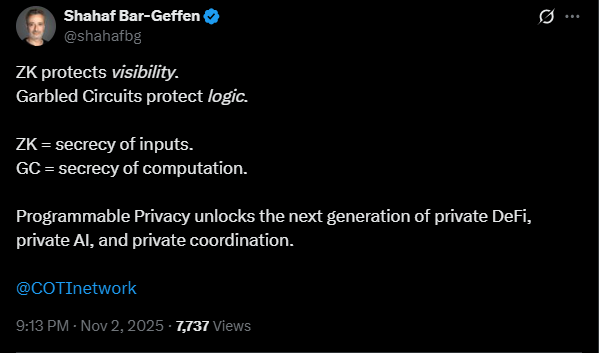TL;DR
- Blockchain has lacked a universal standard for privacy and confidentiality; just as HTTPS became the baseline for secure web traffic, COTI aims to be the baseline for private computation on-chain.
- Governance, DeFi, real-world assets and AI-enabled finance all demand not just encryption of data, but encryption of logic - and COTI's use of garbled circuits answers that need.
- By combining performance, privacy, programmability and compliance, COTI is positioning itself as the infrastructure layer many blockchain applications will rely on - much as HTTPS underpins web-based commerce today.
- Its programmable privacy and high-speed garbled circuits redefine how confidentiality can coexist with compliance.
- COTI could become the baseline privacy layer for the next generation of blockchain applications.
When the World Wide Web moved from HTTP to HTTPS, it triggered a sea-change: trust, privacy and security became the default rather than the exception. Suddenly any website handling payments, forms or user data needed encrypted transport. It didn't require special permission or deep technical knowledge; it became standardized.
Blockchain is nearing a similar inflection point. For years the narrative was "decentralised, open, permissionless". But as applications matured - DeFi, real-world assets, institutional finance, AI-driven workflows - privacy and confidentiality have become baseline requirements, not optional extras.
Enter COTI. Instead of just offering "private transfers", it offers "private logic" and "private computation" - the next layer of stealth functionality for blockchain. If the current era is HTTP, COTI aims to deliver HTTPS-style assurance for logic and data on-chain.
Why Privacy Standards Matter Now
Transparency was a hallmark of early blockchains. Everyone could verify transactions, check ledgers, and ensure no one cheated. That level of openness built trust. But now the picture is more complicated. Businesses, governments and even regular users are asking: if everything is visible, how do you protect strategy, identity, data flows or algorithmic logic?

Blockchain's very strength - auditable ledgers becomes a liability when algorithms, credit decisions, identity flows and real-world assets are involved. As the ecosystem broadens, standardisation of privacy will be critical. Just like HTTPS didn't invent encryption, it made it seamless and universal. Blockchain needs an equivalent standard - and that's where COTI's architecture enters the frame.
The Technical Leap: Garbled Circuits & Programmable Privacy
Most attention in blockchain privacy has gone to Zero-Knowledge Proofs (ZKPs). They allow someone to prove knowledge of an input or state without revealing it. They are powerful for many use-cases, but they focus more on visibility of data, not always on visibility of logic or state transitions.
COTI takes a slightly different tack:

In plain terms: while a standard ZK system lets you hide who or what, garbled circuits let you hide how and why. The computational logic runs in encrypted form. Inputs are hidden. Outputs may or may not be visible. And the internal logic is never exposed.
Performance matters. The COTI's benchmark says:
These metrics matter because privacy is often traded off for speed or cost. If confidentiality means "too slow" or "too expensive", it never becomes standard. COTI is staking its claim that private computation can be performant and scalable - two prerequisites for mainstream adoption.
From Private Transfers to Private DeFi, RWA and Private AI
When HTTPS became standard, it unlocked e-commerce, online banking, SaaS, cloud services and more. Without that layer of encrypted trust, many online behaviours would not scale. Similarly, for blockchain to become infrastructure for finance, AI, identity and global coordination, it cannot depend on optional privacy add-ons - it needs built-in, standardised privacy.
COTI's claim is that it enables this paradigm: programmable privacy - where applications choose which parts of workflows stay private and which parts remain auditable. Consider these scenarios:
- A DeFi protocol where trading volumes and counterparty identities remain hidden, but regulatory proof is still provided.
- AI models processing sensitive user data or credit information, yet settling outcomes on-chain without exposing data.
- Real-world asset tokenisation where contract terms, collateral logic or arbitrage paths are hidden, but settlement is public and auditable.
- CBDCs needing conditional payments: verify compliance without exposing details.
In all these, you need confidential but verified operations. That's the "HTTPS moment" for blockchain - a baseline of trust, encryption and logic control - and COTI claims to deliver it.
Standardisation, Compliance and The Path to Adoption

One reason HTTPS penetrated everywhere was standardisation: browsers enforced it, certificates became cheap, users accepted the padlock icon. The network effect locked in trust.
In blockchain, privacy has been fragmented: shielded pools, optional modes, special coins, add-on layers. That fragmentation slows adoption, especially for regulated industries or enterprises that require audit trails, governance, compliance and performance. The architecture matters.
COTI's architecture offers:
- Selective disclosure: As COTI's CEO Says "We've not built a solution that is all or nothing... It offers selective disclosure, enabling users to decide what you disclose to whom."
- Compatibility: Designed to integrate with EVM tooling, smart contracts, developer frameworks.
- Scalability: Optimised for speed and efficiency, lowering the barrier for privacy-enabled applications.
- Compliancy friendly: Built with auditability, optional exposure and enterprise-grade logic in mind.
In short, if blockchain privacy is ever going to become standard (rather than niche), it needs to be easy, fast, auditable and usable. COTI is positioning itself to satisfy all four.
Why This Could Be the Moment
Regulatory pressure is mounting. Privacy coins and opaque systems face scrutiny. A system that offers privacy and auditability has an advantage. Institutional adoption is growing. Banks, asset managers and governments now consider blockchain for tokenised finance and AI-driven workflows. They will demand confidentiality, performance and compliance.
AI and data workloads are exploding. Data breaches, model theft, competition for data are real risks. Blockchain logic privacy becomes a real need, not just a nice-to-have. Network economics follow standards. Just as HTTPS unlocks commerce, programmable privacy could unlock new flows of value: private DeFi, private trading, private RWA structures.
When all that intersects, the baseline infrastructure has to step up. If COTI succeeds in becoming the standard layer for privacy logic, it will have delivered the equivalent of HTTPS for blockchain - bridging trust, confidentiality and programmability.
Challenges to Watch
Of course, no infrastructure champion is guaranteed success. Some of the challenges ahead:
- Ensuring developer adoption: Tools, SDKs, documentation, frameworks all matter.
- Demonstrating real-world usage: Proofs of large scale deployments will cement trust.
- Competing technologies: ZK-proofs, FHE, MPC are all evolving; COTI must stay ahead.
- Standardisation beyond cryptography: Ecosystem, governance, interoperability and regulation all play a role.
- Understanding trade-offs: Even "programmable privacy" requires design discipline - misused or misconfigured logic can still leak information.
Final Thought
If the web needed HTTPS before it could scale commerce, privacy and trust, the blockchain era needs its own trust standard - not just "private coin transfers" but "private logic and computation." COTI positions itself as that standard. By combining Garbled Circuits, performance, selective disclosure and compliance-ready architecture, COTI aims to become the invisible layer powering logic that must remain confidential - while still being verified, auditable and performant.
In doing so, COTI could deliver the "HTTPS moment" for blockchain: encryption, trust and functionality, all built-in by default.











